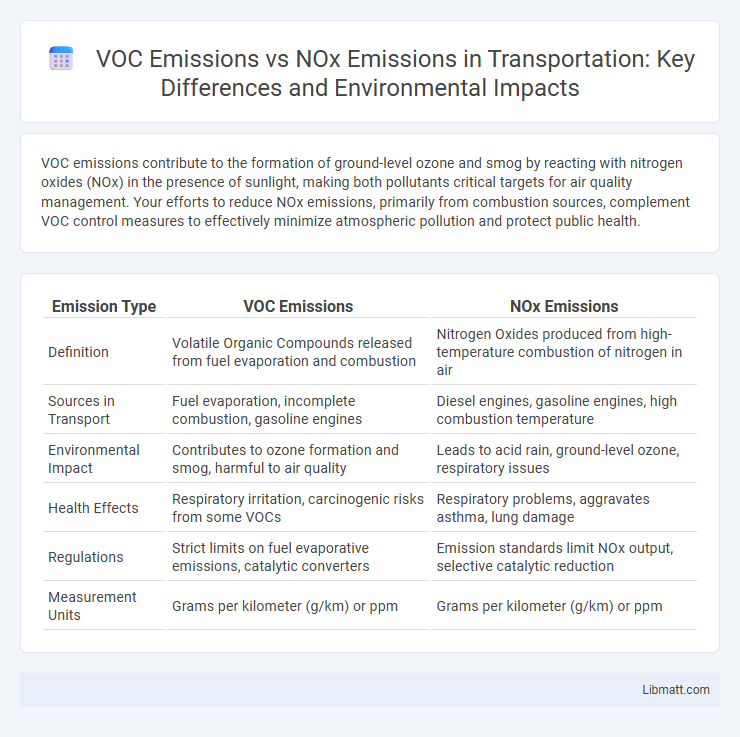VOC emissions contribute to the formation of ground-level ozone and smog by reacting with nitrogen oxides (NOx) in the presence of sunlight, making both pollutants critical targets for air quality management. Your efforts to reduce NOx emissions, primarily from combustion sources, complement VOC control measures to effectively minimize atmospheric pollution and protect public health.
Table of Comparison
| Emission Type | VOC Emissions | NOx Emissions |
|---|---|---|
| Definition | Volatile Organic Compounds released from fuel evaporation and combustion | Nitrogen Oxides produced from high-temperature combustion of nitrogen in air |
| Sources in Transport | Fuel evaporation, incomplete combustion, gasoline engines | Diesel engines, gasoline engines, high combustion temperature |
| Environmental Impact | Contributes to ozone formation and smog, harmful to air quality | Leads to acid rain, ground-level ozone, respiratory issues |
| Health Effects | Respiratory irritation, carcinogenic risks from some VOCs | Respiratory problems, aggravates asthma, lung damage |
| Regulations | Strict limits on fuel evaporative emissions, catalytic converters | Emission standards limit NOx output, selective catalytic reduction |
| Measurement Units | Grams per kilometer (g/km) or ppm | Grams per kilometer (g/km) or ppm |
Understanding VOC Emissions: Sources and Characteristics
VOC emissions primarily originate from industrial processes, vehicle exhaust, and the evaporation of solvents and fuels, releasing volatile organic compounds into the atmosphere. These compounds vary widely in chemical structure and reactivity, influencing their role in forming ground-level ozone and photochemical smog. Understanding VOC characteristics helps Your efforts to control air pollution and reduce health risks associated with exposure to these harmful pollutants.
What Are NOx Emissions? Key Origins and Types
NOx emissions primarily consist of nitrogen oxides, including nitric oxide (NO) and nitrogen dioxide (NO2), generated during combustion processes at high temperatures. Key origins of NOx emissions include vehicle engines, power plants, industrial boilers, and agricultural activities, where nitrogen and oxygen react under intense heat. These emissions contribute significantly to air pollution, leading to smog formation, acid rain, and respiratory problems.
Chemical Properties: VOCs vs. NOx
VOCs (Volatile Organic Compounds) are organic chemicals with high vapor pressure that easily evaporate at room temperature, contributing to ozone formation and smog. NOx (Nitrogen Oxides) are reactive gases primarily composed of nitric oxide (NO) and nitrogen dioxide (NO2), key precursors to acid rain and ground-level ozone. Your understanding of their chemical properties helps in targeting effective pollution control strategies for air quality management.
Main Industrial and Environmental Sources
VOC emissions primarily originate from industrial processes such as solvent use, paint manufacturing, and petroleum refining, contributing significantly to urban smog and indoor air pollution. NOx emissions mainly stem from combustion activities in power plants, vehicle engines, and industrial boilers, playing a critical role in forming ground-level ozone and acid rain. Understanding Your facility's specific sources of VOC and NOx emissions helps target effective pollution control strategies and regulatory compliance.
Impact on Air Quality: VOCs Compared to NOx
Volatile Organic Compounds (VOCs) and Nitrogen Oxides (NOx) both significantly impact air quality by contributing to ground-level ozone formation, a harmful air pollutant. VOCs primarily serve as ozone precursors through photochemical reactions with NOx in sunlight, amplifying smog formation and respiratory health issues. NOx emissions not only contribute directly to ozone but also lead to nitrogen dioxide and particulate matter formation, exacerbating air pollution and visibility reduction.
Health Effects: Exposure Risks of VOCs and NOx
Exposure to volatile organic compounds (VOCs) often causes respiratory irritation, headaches, and long-term risks such as liver and kidney damage, with some VOCs classified as carcinogens. Nitrogen oxides (NOx) pose significant respiratory hazards, aggravating asthma, reducing lung function, and contributing to chronic respiratory diseases due to their role in forming ground-level ozone and fine particulate matter. Both VOCs and NOx contribute to indoor and outdoor air pollution, increasing the risk of cardiovascular issues and exacerbating existing health conditions, particularly in vulnerable populations like children and the elderly.
Photochemical Smog Formation: The Role of VOCs and NOx
VOC emissions and NOx emissions interact in the atmosphere to drive the formation of photochemical smog through complex chemical reactions involving sunlight. VOCs act as precursors by reacting with NOx to produce ozone and secondary organic aerosols, key components of photochemical smog. The balance and concentration ratios of VOCs to NOx determine the rate and intensity of smog formation in urban and industrial environments.
Regulations and Standards: VOC vs. NOx Emissions
VOC emissions are regulated primarily under the Clean Air Act through National Ambient Air Quality Standards (NAAQS) set to limit ozone formation, with state agencies enforcing VOC limits in industrial and vehicular sources. NOx emissions face stringent controls due to their role in ground-level ozone and particulate matter pollution, with standards including EPA's Tier 3 vehicle emissions and industrial NOx emission limits under the Acid Rain Program. Regulatory frameworks differentiate VOC and NOx targets by source category, emphasizing reductions through technology upgrades and emission caps to improve air quality and public health.
Control Technologies and Mitigation Strategies
Control technologies for VOC emissions primarily include activated carbon adsorption, thermal and catalytic oxidation, and biofiltration, which effectively reduce volatile organic compounds in industrial exhaust. NOx emissions are mitigated through selective catalytic reduction (SCR), selective non-catalytic reduction (SNCR), and low-NOx burners that target nitrogen oxides in combustion processes. Combining these strategies with process optimization and real-time monitoring enhances overall emission control efficiency and environmental compliance.
Future Trends: Reducing VOC and NOx Emissions
Future trends in reducing VOC and NOx emissions emphasize advanced catalytic converters and low-emission fuel technologies across transportation and industrial sectors. Implementation of stricter regulations and real-time monitoring systems aims to curb air pollutants and improve urban air quality. Your adoption of electric vehicles and energy-efficient industrial processes will significantly contribute to minimizing these harmful emissions.
VOC emissions vs NOx emissions Infographic

 libmatt.com
libmatt.com